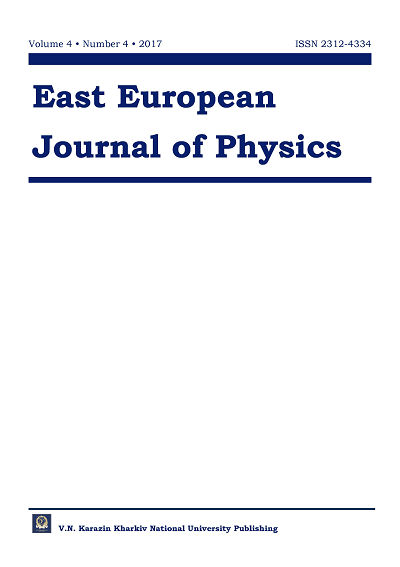THIOFLAVIN T BINDING TO THE MODEL FIBRILS OF LYSOZYME: THE EFFECTS OF FIBRIL TWISTING
Abstract
Amyloid fibrils are highly ordered insoluble protein aggregates that are involved in molecular etiology of a number of severe disorders, including Alzheimer's, Parkinson’s and prion’s diseases, some types of systemic amyloidosis, etc. One of the most effective approaches to detecting the amyloid fibrils is based on monitoring the spectral behavior of specific fluorescent dye Thioflavin T (ThT). Using the molecular docking and molecular dynamics tools, such as PatchDock, FireDock, CreateFibril and GROMACS, the model of twisted K-peptide fibril that supposedly represent the core region of lysozyme amyloid fibrils, has been constructed and analyzed. The effect of fibril twisting angle on the binding characteristics of ThT has been evaluated. The results obtained strongly suggest that ThT specificity for the twisted ribbon fibril polymorphs is primarily determined by the curvature effects rather than amino acid composition of fibril grooveswhich accomodate ThT molecule.
Downloads
References
2. Tokunaga Y., Sakakibara Y., Kamada Y., Watanabe K., Sugimoto Y. Analysis of сore region from egg white lysozyme forming amyloid fibrils // Int. J. Biol. Sci. – 2013. - Vol. 9. – P. 219–227.
3. Aggeli A., Nyrkova I.A., Bell M., Harding R., Carrick L., McLeish T. C. B., Semenov A. N., Boden N. Hierarchical self-assembly of chiral rod-like molecules as a model for peptide β-sheet tapes, ribbons, fibrils, and fibers // Proc. Natl. Acad. Sci. USA. – 2001. – Vol. 98. – P. 11857–11862.
4. Adamcik J., Mezzenga R. Adjustable twisting periodic pitch of amyloid fibrils // Soft Matter. – 2011. – Vol. 7. – P. 5437-5443.
5. Nelson R., Eisenberg D. Recent atomic models of amyloid fibril structure // Curr. Opinion in Struct. Bio. – 2006. – Vol. 16. – P. 260–265.
6. Schneidman-Duhovny D., Inbar Y., Nussinov R., Wolfson H.J. PatchDock and SymmDock: servers for rigid and symmetric docking // Nuc. Acids Res.. – 2005. – Vol. 33. – P. 363–367.
7. Duhovny D., Nussinov R., Wolfson H.J. Efficient Unbound Docking of Rigid Molecules // In Gusfield et al., Ed. Proceedings of the 2'nd Workshop on Algorithms in Bioinformatics (WABI), pp. 185-200, Springer Verlag, 2002
8. Andrusier N., Nussinov R., Wolfson H.J. FireDock: Fast interaction refinement in molecular docking // Proteins. – 2007. – Vol. 69. – P. 139-159.
9. Felice F.G., Vieira M.N.N., Meirelles M.N.L., Morozova-roche L.A., Dobson C.M., Ferreira S.T. Formation of amyloid aggregates from human lysozyme and its disease-associated variants using hydrostatic pressure // FASEB J. – 2004. – Vol. 18. – P. 1099-1101.
10. Ibrahim H., Thomas U., Pellegrini A. A helix-loop-helix peptide at the upper lip of the active site cleft of lysozyme confers potent antimicrobial activity with membrane permeabilization action // J. Biol. Chem. – 2001. – Vol. 276. – P. 43767-43774.
11. Frare E., Mossuto M., Polverino de Laureto P., Dumoulin M., Dobson C., Fontana A. Identification of the core structure of lysozyme amyloid fibrils by proteolysis // J. Mol. Biol. – 2006. – Vol. 361. – P. 551-561.
12. Voropai E.S., Samtsov M.P., Kaplevskii K.N., Maskevich A.A., Stepuro V.I., Povarova O.I., Kuznetsova I.M., Turoverov K.K., Fink A.L., Uverskiid V.N. Spectral properties of thioflavin T and its complexes with amyloid fibrils // J. of App. Spectroscopy. – 2003. – Vol. 70(6). – P. 868-874.
13. Stsiapura V.I., Maskevich A.A., Kuzmitsky V.A., Turoverov K.K., Kuznetsova I.M. Computational study of thioflavin T torsional relaxation in the excited state // J. Phys. Chem. – 2007. – Vol. 111. – P. 4829-4835.
Authors who publish with this journal agree to the following terms:
- Authors retain copyright and grant the journal right of first publication with the work simultaneously licensed under a Creative Commons Attribution License that allows others to share the work with an acknowledgment of the work's authorship and initial publication in this journal.
- Authors are able to enter into separate, additional contractual arrangements for the non-exclusive distribution of the journal's published version of the work (e.g., post it to an institutional repository or publish it in a book), with an acknowledgment of its initial publication in this journal.
- Authors are permitted and encouraged to post their work online (e.g., in institutional repositories or on their website) prior to and during the submission process, as it can lead to productive exchanges, as well as earlier and greater citation of published work (See The Effect of Open Access).








